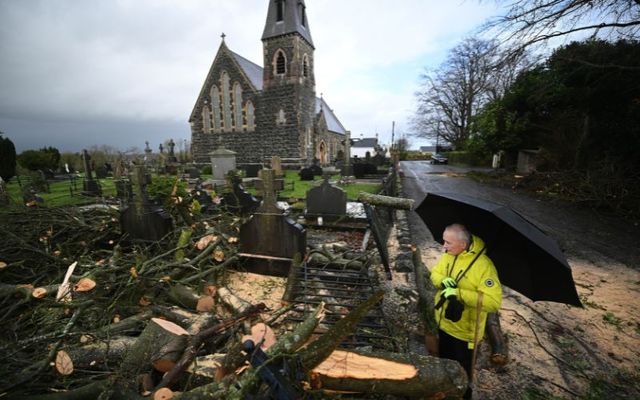Storm Jocelyn is set to hit Ireland between Tuesday and Wednesday as many parts of the country still grapple with power outages stemming from Storm Isha.
Met Éireann, the Irish meteorological service, has issued several weather warnings that will come into effect on Tuesday.
A Status Orange wind warning is in place for Co Donegal from 6 pm on Tuesday thgouh 2 am on Wednesday, while another Status Orange wind warning is in place for Cos Galway and Mayo from 6 pm on Tuesday until 12 am on Wednesday.
"Storm Jocelyn will bring very strong southwest to west winds with severe and damaging gusts," Met Éireann said as part of its Status Orange wind warnings. Potential impacts include large coastal waves with wave overtopping, very difficult traveling conditions, fallen trees, damage to power lines, and damage to already weakened structures.
Several Status Yellow wind warnings have also been issued for counties across Ireland at varying times between Tuesday and Wednesday:
- Cos Clare, Kerry, Galway, and Mayo - effective 12 pm on Tuesday through 2 am on Wednesday
- Cos Donegal, Leitrim, and Sligo - effective 12 pm on Tuesday through 5 am on Wednesday
- Leinster and Cos Cavan, Monaghan, Cork, Limerick, Tipperary, Waterford, and Roscommon - 5 pm Tuesday through 2 am on Wednesday.
As part of its Status Yellow wind warnings, Met Éireann has forecast "very strong and gusty southwest to west winds." Potential impacts include large coastal waves with wave overtopping, difficult traveling conditions, and debris / loose objects displaced.
The UK Met Office has its own Status Yellow wind warning in place for all of Northern Ireland between 4 pm on Tuesday and 1 pm on Wednesday.
Storm Isha tore through Ireland on Sunday with high winds that prompted widespread power outages.
ESB Networks said that as of 8:45 pm on Monday, 68,000 homes, farms, and businesses remained without power following the storm-force winds associated with Storm Isha which caused "significant damage to the electricity network across the country." Approximately 167,000 homes, farms, and businesses had had their power restored.
ESB said all of its available resources and partner contractors would work through Monday night to restore power to as many customers as possible before mobilizing again at first light on Tuesday morning.
However, due to the scale of the damage to the electricity network, ESB said many customers will remain without power on Monday night while some customers will be without power for a number of days.
The areas where customers will remain without supply overnight on Monday are predominantly in the Northwest of Ireland, including counties Cavan, Donegal, Leitrim, Mayo, and Sligo.
ESB said that the Met Éireann status Orange and Yellow level wind warnings associated with Storm Jocelyn may hamper restoration efforts in areas already most affected by Storm Isha.
“It is important that any impacted customers who use electrically powered medical devices contact their healthcare professional to make alternative arrangements if necessary," ESB said on Monday.
“We apologize for the disruption to family and commercial life this causes, and thank customers across the country, especially those who will be without power overnight, for their patience as our crews work to safely restore power.
ESB said that people should “never, ever touch or approach” fallen wires or damaged electricity networks and should instead report any damage by calling 1800 372 999.
Meanwhile, Uisce Éireann also said on Monday that a number of its plants and pumping stations, particularly in the North West of Ireland, had been impacted by power outages or poor raw water quality due to flooding.
Uisce Éireann, who said it had implemented its emergency response processes, added: “We also appeal to customers to check for bursts and overflowing troughs on their own properties and turn these off where they are found.
"Our crews are on the ground working to tackle leaks and maximize our treatment capacity and we are asking the public for their support to help reduce the overall demand by preventing avoidable loss of water and conserving water.”




Comments